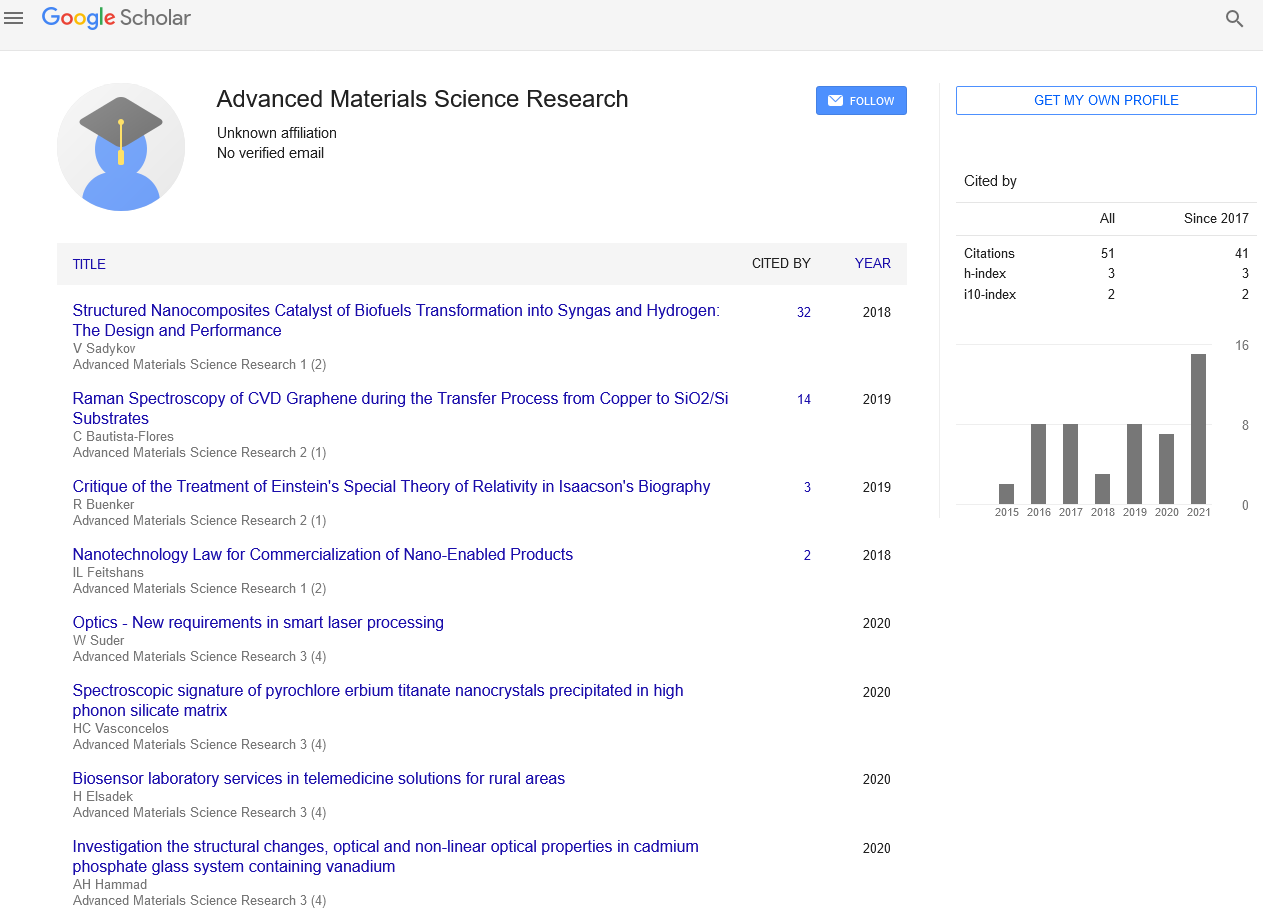Editorial - Advanced Materials Science Research (2023) Volume 6, Issue 4
Advancing Materials Science Research Exploring the Frontiers of Innovation
Deepesh Khan*
Department of Humanities and Social Sciences, Macao Polytechnic University, China
Department of Humanities and Social Sciences, Macao Polytechnic University, China
E-mail: Dkhan34@gmail.com
Received: 03-Apr-2023, Manuscript No. AAAMSR-23-97148; Editor assigned: 05-Apr-2023, Pre-QC No. AAAMSR-23-97148 (PQ); Reviewed: 19-Apr-2023, QC No. AAAMSR-23-97148; Revised: 21-Apr-2023, Manuscript No. AAAMSR-23-97148 (R); Published: 28-Apr-2023; DOI: 10.37532/ aaasmr.2023.6(4).46-48 Editorial
Abstract
Materials science research plays a pivotal role in shaping technological advancements, driving innovation, and improving the quality of human life. This abstract delves into the diverse frontiers of innovation within the field of materials science, highlighting the recent breakthroughs and exploring the implications for various industries and applications. The abstract begins by emphasizing the fundamental importance of materials in modern society, underlining their role in supporting critical technologies such as renewable energy, transportation, healthcare, and electronics. With the constant quest for improved performance, efficiency, and sustainability, researchers in materials science have been relentlessly exploring novel materials and groundbreaking fabrication techniques. The first section of the abstract concentrates on exploring advanced materials, including metamaterials, 2D materials, and nanocomposites. Metamaterials, engineered structures with unique properties derived from their intricate microstructures, open unprecedented possibilities for manipulating electromagnetic waves, enabling revolutionary applications in telecommunications, imaging, and cloaking technology. The rise of 2D materials, like graphene and transition metal dichalcogenides, continues to captivate researchers due to their extraordinary electrical, mechanical, and optical properties, showing promise in flexible electronics, sensors, and energy storage devices. Additionally, nanocomposites, combining nanoparticles with traditional materials, exhibit exceptional strength, durability, and multifunctionality, revolutionizing various industries, from aerospace to biomedical applications. The innovative fabrication techniques, such as additive manufacturing, quantum materials synthesis, and biomimetic design. Additive manufacturing, or 3D printing, offers unparalleled flexibility in producing intricate structures, paving the way for customized components, reduced waste, and streamlined supply chains. Quantum materials synthesis techniques, including epitaxial growth and molecular beam epitaxial, have led to the discovery of materials with emergent properties, providing a potential platform for quantum computing and superconducting technologies. Biomimetic design draws inspiration from nature's structural and functional diversity, resulting in materials with unique properties, such as self-healing, adaptability, and increased sustainability Furthermore, it touches on the significance of sustainability and ethical considerations in materials research, as society seeks to minimize environmental impacts and promote responsible innovation. As the world faces ever-increasing challenges, from climate change to global health, the advancement of materials science holds the key to unlocking a more sustainable, technologically advanced, and interconnected future
Keywords
Materials science • Human life • Renewable energy • Nanocomposites • Biomedical
Introduction
Materials science is a dynamic field that plays a pivotal role in driving technological advancements and shaping various industries. Over the years, researchers and scientists have continually pushed the boundaries of materials science, exploring new materials and developing innovative applications. This article delves into the realm of advanced materials science research, highlighting some groundbreaking discoveries and their potential implications across different sectors [1,2].
Sustainable open innovation
Innovation does not automatically lead to societal progress, better quality of life, or sustainable development. In fact, new technologies may aggravate sustainability problems by magnifying consumer needs Regardless, innovation has great potential toward sustainability-oriented transformation in individuals, organizations, and community’s [3,4] .There is a growing body of research proposing various ways to combine sustainable development and innovation . For instance, sustainability-oriented innovation implies introducing changes to an organization’s philosophy and values-as well as to its products, processes or practices-to create and realize social and environmental value in addition to economic returns. On the other hand, sustainability-driven innovation highlights the importance of the stakeholder effect, emphasizing the significance of stakeholder pressures forcing businesses to embrace sustainability [5].
Nanotechnology and nanomaterials
Nanotechnology has revolutionized materials science, enabling scientists to manipulate materials at the atomic and molecular scale. By harnessing the unique properties of nanomaterials, researchers have opened up a myriad of possibilities [6]. For instance, carbon nanotubes have exhibited exceptional strength, electrical conductivity, and thermal stability, paving the way for advancements in electronics, energy storage, and composite materials.
Biomaterials and tissue engineering
The development of biomaterials and tissue engineering has transformed healthcare and regenerative medicine. Researchers have engineered materials that mimic the properties of natural tissues and organs, allowing for the creation of functional replacements. Biomaterials, such as biodegradable polymers and hydrogels, have shown great potential in drug delivery systems, implants, and artificial organs, providing hope for patients in need of medical interventions [7].
Smart and functional materials
Smart materials are designed to respond to external stimuli, adapting their properties to changing conditions. For instance, shape memory alloys have the ability to return to their original shape after deformation, making them valuable in aerospace, robotics, and biomedical applications [8]. Furthermore, materials with self-healing properties are being developed, promising increased durability and longevity for various products.
Energy materials and sustainability
Addressing global energy challenges requires the development of advanced energy materials. Research efforts have focused on improving energy conversion and storage devices, such as batteries and solar cells. For instance, perovskite solar cells have emerged as a promising alternative to traditional silicon-based cells, offering higher efficiency and lower production costs [9]. Additionally, materials for energy harvesting, such as piezoelectric and thermoelectric materials, hold immense potential in capturing and utilizing wasted energy.
Quantum materials
Quantum materials are at the forefront of cuttingedge materials science research. These materials exhibit unique quantum mechanical properties that can revolutionize various fields, including computing, sensing, and communication. For example, superconductors that can carry electric current without resistance have the potential to transform power transmission and storage [10]. Moreover, topological insulators and quantum dots are being explored for their applications in quantum computing and information processing.
Conclusion
Advanced materials science research is driving innovation across multiple sectors, transforming industries, and improving the quality of life for people worldwide. The fields of nanotechnology, biomaterials, smart materials, energy materials, and quantum materials hold immense potential for groundbreaking discoveries and technological breakthroughs. As researchers continue to explore the frontiers of materials science, we can anticipate even more remarkable advancements that will shape the future of technology, medicine, energy, and beyond.
References
- Geoffrey AO, Kuperman A, Stein A. Advanced zeolite, materials science. AngewChem IntEdEngl. 28,359-376(1989).
- Himanen L, Geurts A, Foster AS et al. Data‐driven materials science: status, challenges, and perspectives.AdvSci.7, 1900808(2019).
- Obidin N, Tasnim F, Dagdeviren C. The future of neuroimplantable devices: a materials science and regulatory perspective.Adv Mater.32, 1901482(2020).
- Louie SG, Chan YH, Jornada FH et al. Discovering and understanding materials through computation. Nat Mater. 20, 728-735(2021).
- Pablo D, Juan K. Advancing and Accelerating Materials Innovation: New Frontiers for the Materials Genome Initiative.41, (2019).
- Ahmadpoor D, Mohammad V, Benjamin F et al. The dual frontier: Patented inventions and prior scientific advance. Science.357,583-587(2017).
- Shipp SS, Gupta N, Scott JA, et al. Advancing manufacturing to new frontiers: Increasing opportunities for society.7, 71-81(2012).
- Xie D, Li Z, Zhu H et al. Recent advances in wearable tactile sensors: Materials, sensing mechanisms, and device performance. MaterSciEng. 115, 1-37 (2017).
- Berggren K, Likharev KK., Strukov DB et al. Roadmap on emerging hardware and technology for machine learning. Nat Nanotechnol.32, 012002(2020).
- Karniadakis GE, Kevrekidis IG, Yang L et al. Physics-informed machine learning.NatRevPhys. 3, 422-440(2021).
Indexed at, Google Scholar, Crossref
Indexed at, Google Scholar, Crossref
Indexed at, Google Scholar, Crossref
Indexed at, Google Scholar, Crossref
Indexed at, Google Scholar, Crossref
Indexed at, Google Scholar, Crossref
Indexed at, Google Scholar, Crossref

